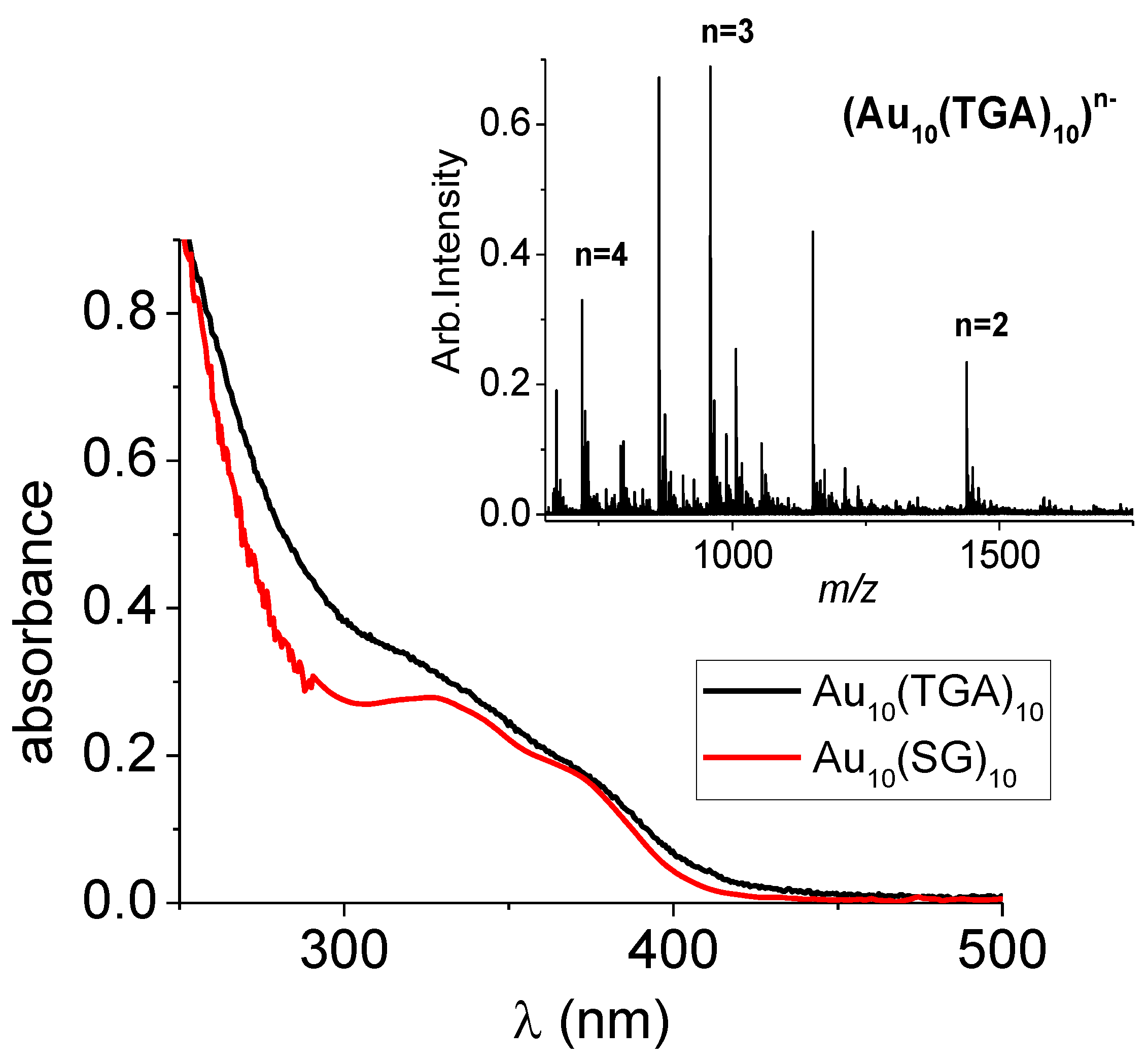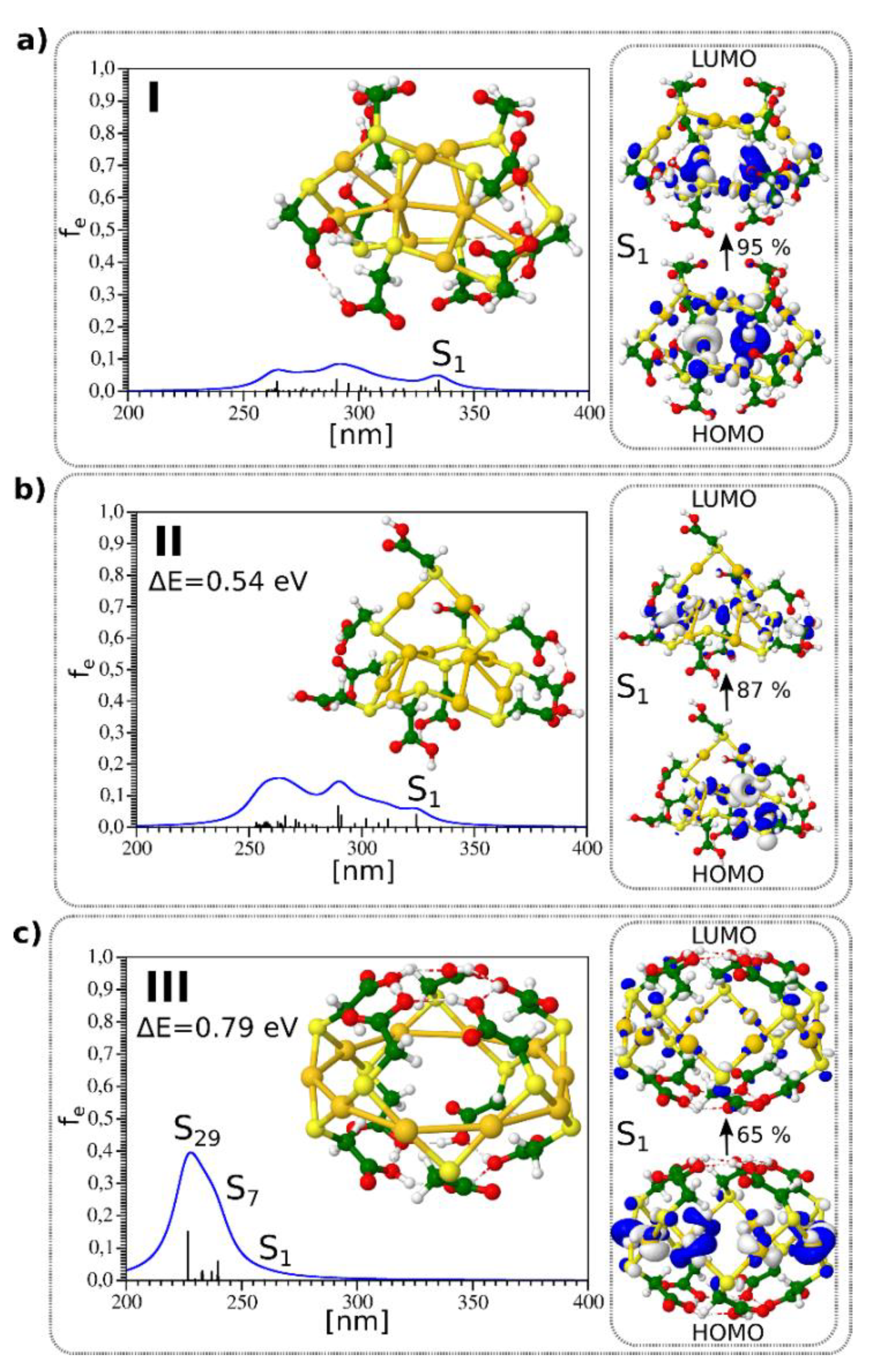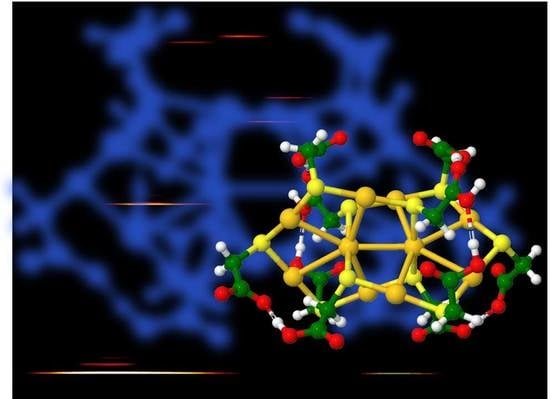Catenane Structures of Homoleptic Thioglycolic Acid-Protected Gold Nanoclusters Evidenced by Ion Mobility-Mass Spectrometry and DFT Calculations
Abstract
1. Introduction
2. Materials and Methods
3. Results and Discussion
3.1. Characterization of Au10(TGA)10
3.2. Theoretical Investigation of the Structural and Optical Properties of Au10(TGA)10
3.3. Catenane Structures of Homoleptic Au10(TGA)10 Evidenced by Ion Mobility-Mass Spectrometry and DFT Calculations
4. Conclusions
Supplementary Materials
Author Contributions
Funding
Acknowledgments
Conflicts of Interest
References
- Jin, R.; Zeng, C.; Zhou, M.; Chen, Y. Atomically Precise Colloidal Metal Nanoclusters and Nanoparticles: Fundamentals and Opportunities. Chem. Rev. 2016, 116, 10346–10413. [Google Scholar] [CrossRef] [PubMed]
- Chakraborty, I.; Pradeep, T. Atomically Precise Clusters of Noble Metals: Emerging Link between Atoms and Nanoparticles. Chem. Rev. 2017, 117, 8208–8271. [Google Scholar] [CrossRef] [PubMed]
- Antoine, R. Atomically precise clusters of gold and silver: A new class of nonlinear optical nanomaterials. Front. Res. Today 2018, 1, 01001. [Google Scholar] [CrossRef]
- Liu, Y.; Tian, Z.; Cheng, L. Size evolution and ligand effects on the structures and stability of (AuL)n (L = Cl, SH, SCH3, PH2, P(CH3)2, n = 1-13) clusters. RSC Adv. 2016, 6, 4705–4712. [Google Scholar] [CrossRef]
- Wiseman, M.R.; Marsh, P.A.; Bishop, P.T.; Brisdon, B.J.; Mahon, M.F. Homoleptic Gold Thiolate Catenanes. J. Am. Chem. Soc. 2000, 122, 12598–12599. [Google Scholar] [CrossRef]
- Chui, S.S.-Y.; Chen, R.; Che, C.-M. A Chiral [2]Catenane Precursor of the Antiarthritic Gold(I) Drug Auranofin. Angew. Chem. Int. Ed. 2006, 45, 1621–1624. [Google Scholar] [CrossRef] [PubMed]
- Bertorelle, F.; Russier-Antoine, I.; Calin, N.; Comby-Zerbino, C.; Bensalah-Ledoux, A.; Guy, S.; Dugourd, P.; Brevet, P.-F.; Sanader, Ž.; Krstić, M.; et al. Au10(SG)10: A Chiral Gold Catenane Nanocluster with Zero Confined Electrons. Optical Properties and First-Principles Theoretical Analysis. J. Phys. Chem. Lett. 2017, 8, 1979–1985. [Google Scholar] [CrossRef] [PubMed]
- Jiang, D.-E.; Overbury, S.H.; Dai, S. Structure of Au15(SR)13 and Its Implication for the Origin of the Nucleus in Thiolated Gold Nanoclusters. J. Am. Chem. Soc. 2013, 135, 8786–8789. [Google Scholar] [CrossRef]
- Pei, Y.; Pal, R.; Liu, C.; Gao, Y.; Zhang, Z.; Zeng, X.C. Interlocked Catenane-Like Structure Predicted in Au24(SR)20: Implication to Structural Evolution of Thiolated Gold Clusters from Homoleptic Gold(I) Thiolates to Core-Stacked Nanoparticles. J. Am. Chem. Soc. 2012, 134, 3015–3024. [Google Scholar] [CrossRef] [PubMed]
- Pei, Y.; Wang, P.; Ma, Z.; Xiong, L. Growth-Rule-Guided Structural Exploration of Thiolate-Protected Gold Nanoclusters. Accounts Chem. Res. 2019, 52, 23–33. [Google Scholar] [CrossRef]
- Chevrier, D.M.; Thanthirige, V.D.; Luo, Z.; Driscoll, S.; Cho, P.; MacDonald, M.A.; Yao, Q.; Guda, R.; Xie, J.; Johnson, E.R.; et al. Structure and formation of highly luminescent protein-stabilized gold clusters. Chem. Sci. 2018, 9, 2782–2790. [Google Scholar] [CrossRef]
- Angel, L.A.; Majors, L.T.; Dharmaratne, A.C.; Dass, A. Ion Mobility Mass Spectrometry of Au25(SCH2CH2Ph)18 Nanoclusters. ACS Nano 2010, 4, 4691–4700. [Google Scholar] [CrossRef] [PubMed]
- Harkness, K.M.; Fenn, L.S.; Cliffel, D.E.; McLean, J.A. Surface Fragmentation of Complexes from Thiolate Protected Gold Nanoparticles by Ion Mobility-Mass Spectrometry. Anal. Chem. 2010, 82, 3061–3066. [Google Scholar] [CrossRef] [PubMed]
- Baksi, A.; Harvey, S.R.; Natarajan, G.; Wysocki, V.H.; Pradeep, T. Possible isomers in ligand protected Ag11 cluster ions identified by ion mobility mass spectrometry and fragmented by surface induced dissociation. Chem. Commun. 2016, 52, 3805–3808. [Google Scholar] [CrossRef] [PubMed]
- Baksi, A.; Ghosh, A.; Mudedla, S.K.; Chakraborty, P.; Bhat, S.; Mondal, B.; Krishnadas, K.R.; Subramanian, V.; Pradeep, T. Isomerism in Monolayer Protected Silver Cluster Ions: An Ion Mobility-Mass Spectrometry Approach. J. Phys. Chem. C 2017, 121, 13421–13427. [Google Scholar] [CrossRef]
- Daly, S.; Choi, C.M.; Zavras, A.; Krstić, M.; Chirot, F.; Connell, T.U.; Williams, S.J.; Donnelly, P.S.; Antoine, R.; Giuliani, A.; et al. Gas-Phase Structural and Optical Properties of Homo- and Heterobimetallic Rhombic Dodecahedral Nanoclusters [Ag14–nCun(C≡CtBu)12X]+ (X = Cl and Br): Ion Mobility, VUV and UV Spectroscopy, and DFT Calculations. J. Phys. Chem. C 2017, 121, 10719–10727. [Google Scholar] [CrossRef]
- Ligare, M.R.; Baker, E.S.; Laskin, J.; Johnson, G.E. Ligand induced structural isomerism in phosphine coordinated gold clusters revealed by ion mobility mass spectrometry. Chem. Commun. 2017, 53, 7389–7392. [Google Scholar] [CrossRef] [PubMed]
- Comby-Zerbino, C.; Bertorelle, F.; Chirot, F.; Dugourd, P.; Antoine, R. Structural insights into glutathione-protected gold Au10−12(SG)10−12 nanoclusters revealed by ion mobility mass spectrometry. Eur. Phys. J. D 2018, 72, 144. [Google Scholar] [CrossRef]
- Soleilhac, A.; Bertorelle, F.; Comby-Zerbino, C.; Chirot, F.; Calin, N.; Dugourd, P.; Antoine, R. Size Characterization of Glutathione-Protected Gold Nanoclusters in the Solid, Liquid and Gas Phases. J. Phys. Chem. C 2017, 121, 27733–27740. [Google Scholar] [CrossRef]
- Simon, A.-L.; Chirot, F.; Choi, C.M.; Clavier, C.; Barbaire, M.; Maurelli, J.; Dagany, X.; MacAleese, L.; Dugourd, P. Tandem ion mobility spectrometry coupled to laser excitation. Rev. Sci. Instrum. 2015, 86, 094101. [Google Scholar] [CrossRef]
- Revercomb, H.E.; Mason, E.A. Theory of plasma chromatography/gaseous electrophoresis. Anal. Chem. 1975, 47, 970–983. [Google Scholar] [CrossRef]
- Bonačić-Koutecký, V.; Kulesza, A.; Gell, L.; Mitrić, R.; Antoine, R.; Bertorelle, F.; Hamouda, R.; Rayane, D.; Broyer, M.; Tabarin, T.; et al. Silver cluster–biomolecule hybrids: From basics towards sensors. Phys. Chem. Chem. Phys. 2012, 14, 9282–9290. [Google Scholar] [CrossRef] [PubMed]
- Bertorelle, F.; Hamouda, R.; Rayane, D.; Broyer, M.; Antoine, R.; Dugourd, P.; Gell, L.; Kulesza, A.; Mitric, R.; Bonacic-Koutecky, V. Synthesis, characterization and optical properties of low nuclearity liganded silver clusters: Ag31(SG)19 and Ag15(SG)11. Nanoscale 2013, 5, 5637–5643. [Google Scholar] [CrossRef] [PubMed]
- Andrae, D.; Häußermann, U.; Dolg, M.; Stoll, H.; Preuß, H. Energy-adjustedab initio pseudopotentials for the second and third row transition elements. Theor. Chi. Acta 1990, 77, 123–141. [Google Scholar] [CrossRef]
- Adamo, C.; Barone, V. Toward reliable density functional methods without adjustable parameters: The PBE0 model. J. Chem. Phys. 1999, 110, 6158–6170. [Google Scholar] [CrossRef]
- Weigend, F.; Ahlrichs, R. Balanced basis sets of split valence, triple zeta valence and quadruple zeta valence quality for H to Rn: Design and assessment of accuracy. Phys. Chem. Chem. Phys. 2005, 7, 3297–3305. [Google Scholar] [CrossRef] [PubMed]
- Larriba-Andaluz, C.; Hogan, C.J., Jr. Collision cross section calculations for polyatomic ions considering rotating diatomic/linear gas molecules. J. Chem. Phys. 2014, 141, 194107. [Google Scholar] [CrossRef] [PubMed]


| CCS of Au10(TGA)10 (Å2) | Au10(TGA)10 neutral | [Au10(TGA)10−2H]2− | [Au10(TGA)10−3H]3− |
|---|---|---|---|
| Exp. | 225 (5) | 235 (5) | |
| [5,5] catenane | 212 | 220 | |
| [6,4] catenane | 228 | 230 | |
| Crown-like | 196 | 196 |
© 2019 by the authors. Licensee MDPI, Basel, Switzerland. This article is an open access article distributed under the terms and conditions of the Creative Commons Attribution (CC BY) license (http://creativecommons.org/licenses/by/4.0/).
Share and Cite
Comby-Zerbino, C.; Perić, M.; Bertorelle, F.; Chirot, F.; Dugourd, P.; Bonačić-Koutecký, V.; Antoine, R. Catenane Structures of Homoleptic Thioglycolic Acid-Protected Gold Nanoclusters Evidenced by Ion Mobility-Mass Spectrometry and DFT Calculations. Nanomaterials 2019, 9, 457. https://doi.org/10.3390/nano9030457
Comby-Zerbino C, Perić M, Bertorelle F, Chirot F, Dugourd P, Bonačić-Koutecký V, Antoine R. Catenane Structures of Homoleptic Thioglycolic Acid-Protected Gold Nanoclusters Evidenced by Ion Mobility-Mass Spectrometry and DFT Calculations. Nanomaterials. 2019; 9(3):457. https://doi.org/10.3390/nano9030457
Chicago/Turabian StyleComby-Zerbino, Clothilde, Martina Perić, Franck Bertorelle, Fabien Chirot, Philippe Dugourd, Vlasta Bonačić-Koutecký, and Rodolphe Antoine. 2019. "Catenane Structures of Homoleptic Thioglycolic Acid-Protected Gold Nanoclusters Evidenced by Ion Mobility-Mass Spectrometry and DFT Calculations" Nanomaterials 9, no. 3: 457. https://doi.org/10.3390/nano9030457
APA StyleComby-Zerbino, C., Perić, M., Bertorelle, F., Chirot, F., Dugourd, P., Bonačić-Koutecký, V., & Antoine, R. (2019). Catenane Structures of Homoleptic Thioglycolic Acid-Protected Gold Nanoclusters Evidenced by Ion Mobility-Mass Spectrometry and DFT Calculations. Nanomaterials, 9(3), 457. https://doi.org/10.3390/nano9030457







